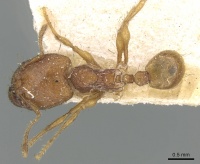Carebara nana
| Carebara nana | |
|---|---|

| |
| Scientific classification | |
| Kingdom: | Animalia |
| Phylum: | Arthropoda |
| Class: | Insecta |
| Order: | Hymenoptera |
| Family: | Formicidae |
| Subfamily: | Myrmicinae |
| Tribe: | Crematogastrini |
| Genus: | Carebara |
| Species: | C. nana |
| Binomial name | |
| Carebara nana (Roger, 1863) | |
Identification
Keys including this Species
Distribution
Latitudinal Distribution Pattern
Latitudinal Range: 11.341799° to 11.341799°.
| North Temperate |
North Subtropical |
Tropical | South Subtropical |
South Temperate |
- Source: AntMaps
Distribution based on Regional Taxon Lists
Oriental Region: India, Sri Lanka (type locality).
Distribution based on AntMaps
Distribution based on AntWeb specimens
Check data from AntWeb
Countries Occupied
| Number of countries occupied by this species based on AntWiki Regional Taxon Lists. In general, fewer countries occupied indicates a narrower range, while more countries indicates a more widespread species. |

|
Estimated Abundance
| Relative abundance based on number of AntMaps records per species (this species within the purple bar). Fewer records (to the left) indicates a less abundant/encountered species while more records (to the right) indicates more abundant/encountered species. |

|
Biology
Castes
Images from AntWeb
   
| |
| Worker. Specimen code casent0906213. Photographer Estella Ortega, uploaded by California Academy of Sciences. | Owned by NHMUK, London, UK. |
Nomenclature
The following information is derived from Barry Bolton's Online Catalogue of the Ants of the World.
- nana. Pheidologeton nanus Roger, 1863a: 191 (s.w.q.) SRI LANKA.
- Type-material: syntype major and minor workers, syntype queens (numbers not stated, “a large number of workers and several queens”).
- Type-locality: Sri Lanka (“Ceylon”): (no further data) (no collector’s name, perhaps J. Nietner).
- Type-depository: MNHU (perhaps also DEIB, ZSBS).
- Combination in Carebara: Fischer, et al. 2014: 72.
- Status as species: Roger, 1863b: 30; Mayr, 1863: 442; Smith, F. 1871a: 332; Dalla Torre, 1893: 73; Emery, 1893f: 243; Mayr, 1897: 429; Emery, 1901f: 120; Forel, 1903a: 691; Bingham, 1903: 165; Forel, 1908a: 3; Forel, 1911i: 220; Emery, 1924d: 213; Chapman & Capco, 1951: 160; Ettershank, 1966: 119; Bolton, 1995b: 333; Guénard & Dunn, 2012: 51; Bharti, Guénard, et al. 2016: 34; Akbar & Bharti, 2017: 37 (in key); Dias, R.K.S. et al. 2020: 65.
- Distribution: China, India, Sri Lanka.
Description
References
- Fischer, G., Azorsa, F. & Fisher, B.L. 2014. The ant genus Carebara Westwood (Hymenoptera, Formicidae): synonymisation of Pheidologeton Mayr under Carebara, establishment and revision of the C. polita species group. ZooKeys 438: 57–112.
- Mayr, G. 1897. Formiciden aus Ceylon und Singapur. Természetr. Füz. 20: 420-436 (page 429, see also)
- Roger, J. 1863a. Die neu aufgeführten Gattungen und Arten meines Formiciden-Verzeichnisses nebst Ergänzung einiger früher gegebenen Beschreibungen. Berl. Entomol. Z. 7: 131-214 (page 191, soldier, worker, queen described)
References based on Global Ant Biodiversity Informatics
- Chapman, J. W., and Capco, S. R. 1951. Check list of the ants (Hymenoptera: Formicidae) of Asia. Monogr. Inst. Sci. Technol. Manila 1: 1-327
- Dias R. K. S. 2002. Current knowledge on ants of Sri Lanka. ANeT Newsletter 4: 17- 21.
- Emery C. 1893. Voyage de M. E. Simon à l'île de Ceylan (janvier-février 1892). Formicides. Annales de la Société Entomologique de France 62: 239-258.
- Emery C. 1901. Ameisen gesammelt in Ceylon von Dr. W. Horn 1899. Deutsche Entomologische Zeitschrift 1901: 113-122.
- Ettershank G. 1966. A generic revision of the world Myrmicinae related to Solenopsis and Pheidologeton (Hymenoptera: Formicidae). Aust. J. Zool. 14: 73-171.
- Forel A. 1903. Les Formicides de l'Empire des Indes et de Ceylan. Part X. J. Bombay Nat. Hist. Soc. 14: 679-715.
- Forel A. 1911. Ameisen aus Ceylon, gesammelt von Prof. K. Escherich (einige von Prof. E. Bugnion). Pp. 215-228 in: Escherich, K. Termitenleben auf Ceylon. Jena: Gustav Fischer, xxxii + 262 pp.
- Forel, A. 1908. Fourmis de Ceylan et d'Égypte récoltées par le Prof. E. Bugnion. Lasius carniolicus. Fourmis de Kerguelen. Pseudandrie? Strongylognathus testaceus. Bull. Soc. Vaudoise Sci. Nat. 44: 1-22
- Ghosh S. N., S. Sheela, B. G. Kundu, S. Roychowdhury, and R. N. Tiwari. 2006. Insecta: Hymenoptera: Formicidae. Pp. 369-398 in: Alfred, J. R. B. (ed.) 2006. Fauna of Arunachal Pradesh. (Part -2). [State Fauna Series 13.]. New Delhi: Zoological Survey of India, iv + 518 pp.
- Guénard B., and R. R. Dunn. 2012. A checklist of the ants of China. Zootaxa 3558: 1-77.
- Hua Li-zhong. 2006. List of Chinese insects Vol. IV. Pages 262-273. Sun Yat-sen university Press, Guangzhou. 539 pages.
- Li Z.h. 2006. List of Chinese Insects. Volume 4. Sun Yat-sen University Press
- Tiwary R. N., and P. K. Maiti. 1976. Some new records of ants from Arunachal Pradesh (Hymenoptera: Formicidae). Newsl. Zool. Surv. India 2(2): 49-50.
- Yamane S. 2003. Preliminary survey on the distribution pattern of southeast Asian Pheidologeton species (Hymenoptera: Formicidae). Pp. 73-86 in: Mohamed, M.; Fellowes, J. R.; Yamane, S. (eds.) 2003. Proceedings of the 2nd ANeT workshop and seminar. Kota Kinabalu: Universiti Malaysia Sabah

